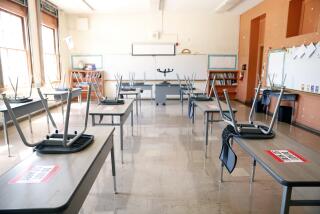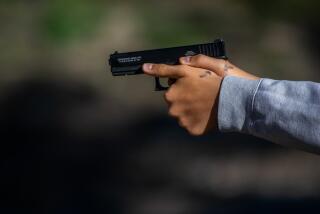The Age of Rage : At Nimitz Middle School, students are taking a course that could save their lives: how to curb anger. In this struggle, everyone wins.
- Share via
Just thinking about it made her teen-age blood boil.
“My mom told me to pick up my room, to make my bed, to cook my breakfast, to hurry up and put on my shoes--and I still had to do my hair!” recalled Selena Aragon, 13.
“I shouted, ‘You know, Mom, I only have two hands. I can’t do everything. I’m not like you!’ ” Selena said she ran into her room, flung a photo of her mother against a wall and raced out the door, her mother yelling, “No going out after school today!”
Six hours after that argument, Selena was still seething. Her blowups have been frequent since her parents’ divorce five years ago. Sometimes she wants to strike her mom, she recently told other students enrolled in the Think First anger-management program at Nimitz Middle School in Southeast Los Angeles.
Repeated visits to the dean’s office have landed them in the seventh-period anti-anger sessions, which Nimitz officials believe are the only such classes offered within the Los Angeles Unified School District. Parents have given their consent and teachers have excused the students from regular classes to participate.
Confessing that she can’t keep her dander down, Selena has plenty of company. Thirty students are enrolled in the classes, which meet weekly.
All of the students have circled 10 on an anger scale drawn on the classroom board. It ranges from 1, a little bit angry, to 10, out of control. One by one, they admitted that more often than they’d like, their adrenaline gets them in trouble. They get uptight when they are gossiped about, or, as they say, “dissed.” They’re even angrier when somebody looks at them the wrong way, or as they put it, “mad-dogs” them. They lash out by cursing and sometimes slugging.
Some said they act on their anger by throwing things, kicking things or breaking things. Others keep their feelings bottled up. When that happens, depression often sets in.
“Anger is a very normal process. You can’t restrict anger; it’s a message and the message is that something is wrong,” Floyd McGregor told the group of girls. The classroom resembles a den, with sofa, matching chairs and overstuffed pillows, which have been punched around since the classes began 18 months ago.
McGregor, a clinical psychology doctoral candidate at the California School of Professional Psychology, instructs three weekly sessions. Rebecca Behar, a psychiatric social worker at Nimitz, helps McGregor with the girls’ group; Henry Gitler, a staff psychologist, helps with the two boys’ sessions.
The students are separated by gender because the model program was developed for boys, Behar said. “Aside from that, it helps to focus students better when the groups are not mixed,” she said.
Principal Lupe Simpson saw a need for the program at Nimitz, the nation’s second-largest middle school, with enrollment of 3,600. “Think First is teaching kids to be responsible for their own behavior because nobody else is teaching them,” she said. “The kids are learning why and what makes them angry. But most of all, they are learning self-control.”
About 50 Nimitz students have gone through the 10-to-15-week program, developed and co-written by Judy McBride, a Long Beach Unified School District psychologist. Results have been positive, Behar said. “Among those students, there has been a reduction of referrals to the dean for fights among students. At homes, parents have told me that there is less arguing, and in many cases grades have improved, which has been an added bonus.”
During the Think First classes, McGregor and counselors boost students’ self-esteem by giving points for good behavior, class participation and honest answers, and rewarding them with popcorn and sodas at the end of each session. At the completion of the course, students receive Think First diplomas during a ceremony attended by parents who, early on, agree to attend Wednesday night parenting classes at which the anger-management program is discussed.
McGregor said students become angry and sometimes violent because they come from broken families, stepfamilies and families in which a parent’s girlfriend or boyfriend has moved in.
“In many homes,” McGregor said, “single parents have lost control.”
He also cites other reasons, such as parents who work long hours or simply aren’t around enough for their children, the effect of television violence, violence at home, poverty and environments of gang violence and drug dealing.
“What you’ve got are some pretty angry teen-agers out there” primed to “act out how they feel,” McGregor said.
He said that because children are seldom taught how to keep a lid on anger, such programs as Think First are important and necessary, especially for middle-school students who are at a crucial stage in their development.
“They are beginning to start to question their own identity, to hang out even more with kids their ages. They start to dress differently. They don’t want to listen to Mom. They question their authority figures” because they are in turmoil about making a transition into their teens, McGregor said.
Often that confusion leads to anger and aggressive behavior, which lands students in the dean’s office.
*
Think First helps students let go of their hostility by helping them identify anger triggers, such as their being yelled at, hit, bossed around or disrespected, or thinking that they are being laughed at, stared at or talked about when they are not, McGregor said.
“I try to get the kids to change their negative thought processes by working on building their self-esteem. I talk to them about being in control because you can be much more powerful by not letting someone get you mad.”
McGregor also shows the youths how to be aware of anger cues or physical reactions, such as clenched fists, tightened stomachs and facial tension, which can escalate to “a guy or a girl really wanting to hit somebody or kick a desk or punch a hole in the wall.”
When that happens, it’s time to employ anger reducers, such as deep breathing.
*
Yolanda Flores, 13, said her anger is out of hand and hopes the classes will help her conquer it. “I get angry every day, three or four times. I show it with my face,” the seventh-grader said, demonstrating a frown and dagger-throwing eyes.
“If I’m cleaning my room, my mom goes, ‘Yolanda, have you taken your shower? Have you eaten? Have you cleaned off the table? Have you done the dishes?’ I can’t take it. I blow up. I hit my little sister. I give her a big old hand. I leave her red.”
Maria Martinez, 11, a sixth-grader, said her anger has driven her to hit her mother in the face. On occasion she’s been angry enough to want to hit all her teachers, she said, adding that she once kicked an elementary-school teacher and was suspended.
She’s trying to figure out why she gets angry. She and the others blame neighborhood violence, older siblings who put them down and call them derogatory names and parents who give them little or no attention.
Maria said she’s learning how to control her anger because “I don’t want to get suspended.”
Neither does Selena, who says she gets uptight because her brothers call her bad names, she’s hassled at home, and at school “my teachers get on me.”
“Most of the time I keep my anger inside of me,” she said. But when it’s uncontrollable, “I go inside my room and throw everything on the floor. I’ll sock the walls and it doesn’t hurt me cause I’m mad. My mom says, ‘Go ahead, do it again and I’m going to hit you.’ So I do it again. I just explode. I go off.”
Eighth-grader Michelle Morales, 14, said her anger gets the best of her because her parents “don’t want to listen to me. They would rather believe my brothers.”
Still, Michelle said, “It feels good coming here because I get to talk about my anger and now I know what to do. It’s a positive thing.”
Talk like that pleases McGregor.
“Kids are like sponges. Once you teach them something that works and they see that it works, they begin to feel positive about themselves.” He said positive thinking helps build self-esteem, which empowers the students. “And when that happens, you can show them how to control their anger.”
*
Juan Sanchez, 15, a recent program graduate, said he has managed to stay calm by remembering to use anger reducers and, when necessary, consult a counselor. He said that before he took the class he was in so much trouble he was about to be transferred to another school.
“Any little thing would set me off. If somebody flipped me off or said something about me, I’d go up to them and say, ‘Tell it to my face,’ and if they did it to my face I’d break their jaw.”
Psychologist Gitler, who recommended the class to Juan, remembered when the student was in the dean’s office three times a week on a regular basis for fighting. His grades were slipping from Cs to Ds. Since he completed the anger program, Juan has chalked up five A’s and one B, and the fights have stopped.
“In Think First, we don’t talk about grades or homework, only about anger. But what he learned seemed to carry over to his classwork,” Gitler said.
Juan’s mother, Gabriela Ramos, recognizes the change in her son.
“He used to be so rebellious. He had an angry character about him--yelling, never listening, screaming at me when I would be talking to him. He wanted to do only what he wanted to do,” she said.
“Now he does his homework. I get on him and he listens and he doesn’t get angry. He actually does what I would like for him to do.”
How to Control Anger
Floyd McGregor, an anger-management consultant at Nimitz Middle School, recommends these techniques for reducing anger:
* Take slow, deep breaths. This relaxes your body and prevents you from hyperventilating.
* Count backward slowly, from 10. Counting helps get your mind off your anger.
* Get a mantra. Repeating phrases such as “kick back,” “cool it” or “mellow out” has a calming effect and helps refocus anger so it doesn’t escalate to violence.
More to Read
Sign up for Essential California
The most important California stories and recommendations in your inbox every morning.
You may occasionally receive promotional content from the Los Angeles Times.













